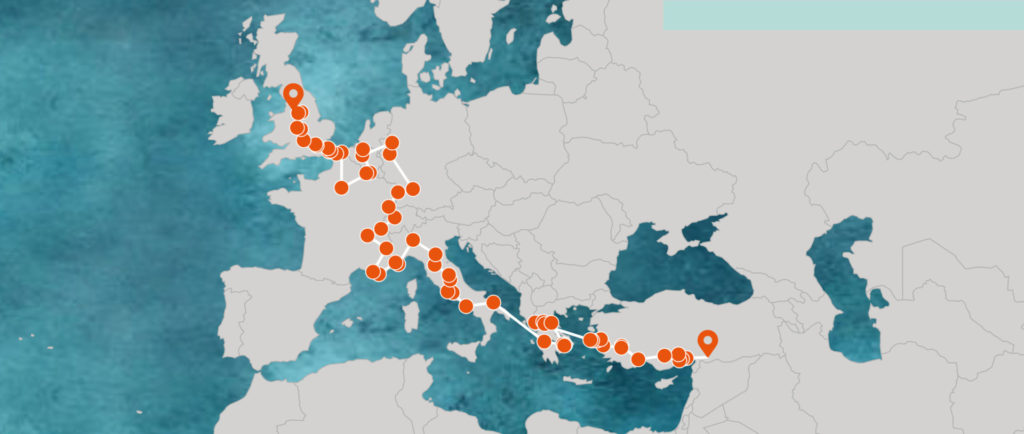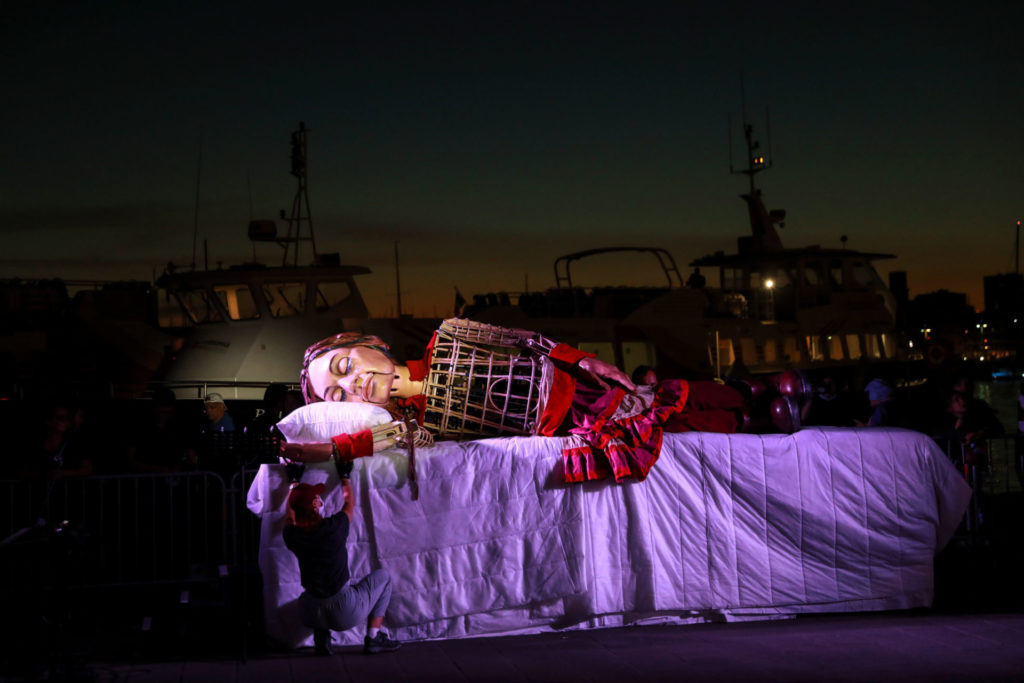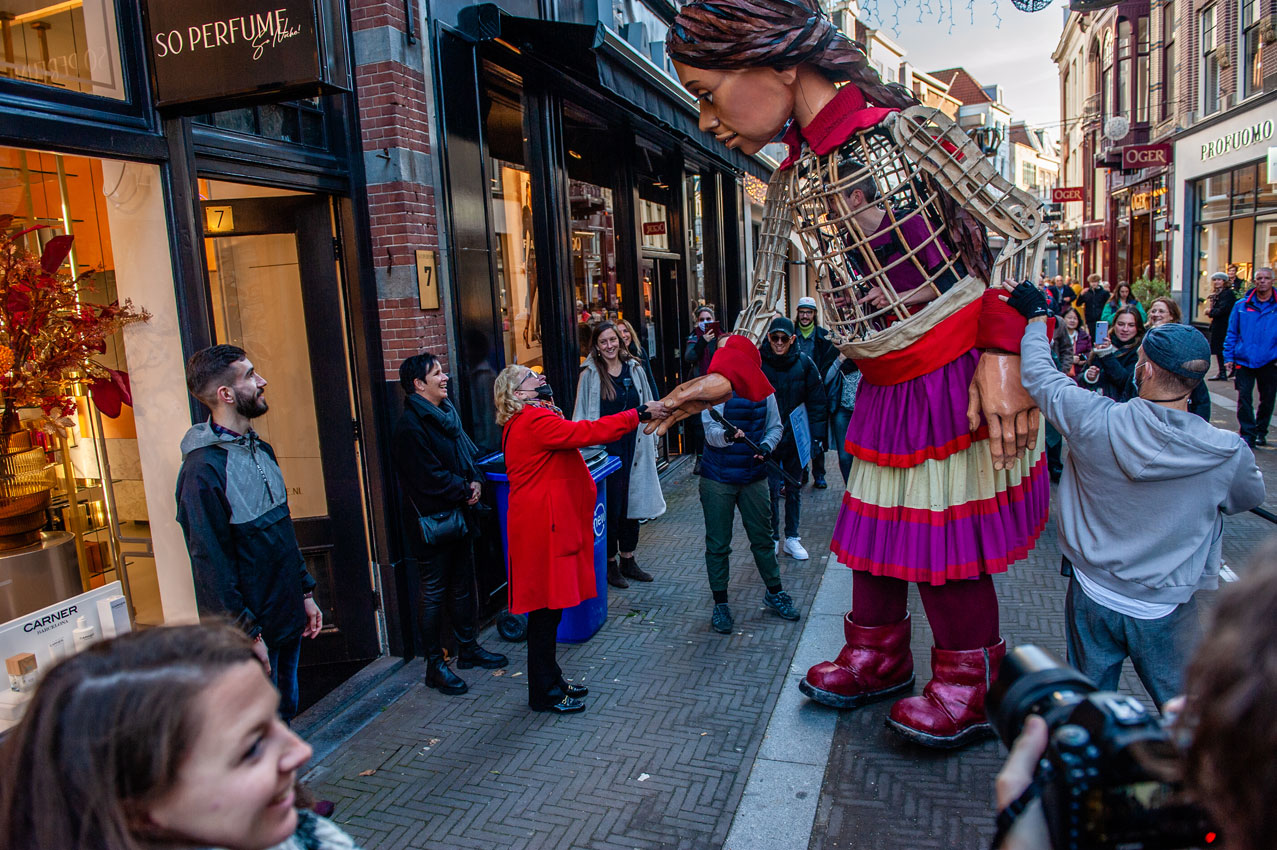“These people are not coming with nothing,” Abdulrazak Gurnah, the Tanzanian British author, told the press shortly after winning the 2021 Nobel Prize in literature in October. “They are coming with youth, with energy, with potential.”
Gurnah was speaking, of course, about migrants and the complex stories behind their odyssey before they find lack of compassion from their hosting governments and societies, for such sad states of affairs have long been the running theme in Gurnah’s work.
These sad states of affairs are also what Little Amal is about. The 11.5-foot puppet made from molded cane and carbon fiber champions the plight and cause of refugees at a time of ongoing mass exoduses that seem to be never-ending.
Amal (Arabic for hope), who represents a 9-year-old Syrian girl looking for her mother, has recently completed a 5,000-mile journey across Europe that began in Gaziantep, Turkey. Produced by Good Chance Theatre, the project, called “The Walk,” aims to draw attention especially to displaced children.
While Little Amal was taking her last steps in northern England in November, the humanitarian crisis on the European Union’s eastern border was playing out to the backdrop of plummeting temperatures that caused the death of entire families who had hailed from Syria, Iraqi Kurdistan and Afghanistan and found themselves stranded in the forests of Belarus and Poland.
Little Amal also made a surprise visit to the COP26 in Glasgow, Scotland, amid talks there of climate change as a driving force for the displacement and migration of what at times seems to be entire nations. In addressing these gargantuan topics, Little Amal has also turned into “perhaps the most ambitious public art project ever attempted,” according to Stephen Daldry, one of the producers of “The Walk.”
The inspiration for Little Amal came from conversations playwright, producer and social anthropologist David Lan engaged in with Daldry. The two had worked together on the production of the 2017 play “The Jungle” about refugees in Calais, France. One of the characters in the play was a 9-year-old girl named Amal, who Lan said had a strong presence even if she didn’t speak much.
“It started out of the need to respond in some way to those who make a journey out of necessity,” said Lan. After having produced “The Jungle,” Lan said, “the truth is, nothing is ever finished. Every time you go out on the street there are homeless people. There’s the inequality of life; some people stay at home and some people have their homes taken away from them.”
An idea began to form: a traveling theatrical event that would roughly follow the route a refugee from Syria takes to get to Europe. It would involve a larger-than-life puppet, Little Amal, with cultural events organized along the way in the eight countries through which Little Amal traveled.
Lan said he had “been thinking about the relationship between a group of people who are traveling and others who receive them, and how you make things together, a lightning collaboration between two groups of people to draw attention to circumstances in which people live.”
Enter three main characters essential to the creation: Handspring Puppet Company, the South African designers of the puppets in the play “War Horse” and, as artistic director, the Palestinian theater director and playwright Amir Nizar Zuabi.
Adrian Kohler and Basil Jones, who both recently turned 70 and are partners in work and life, founded Handspring 40 years ago in apartheid South Africa and were trying to slow down their work pace when they received a call from Lan.
“David is a South African from Cape Town. When I was at school he was already being published as a young poet. He ended up running the Young Vic [theater], so he’s a man of huge reputation and there was a backstory connecting us. So it was very easy to say yes to anything he was suggesting,” said Jones.
“He wanted a 5-meter-high little girl [so that everyone on the ground could see her], and to operate something that high you need cranes and machinery and something on wheels and it becomes a very technical thing,” Kohler said. “But it couldn’t be high tech. The best way to do it would be to have something on stilts and, consulting with Craig Leo, who is a stilt walker and a fabulous puppeteer in Cape Town, we hit on a 3.5-meter-tall [11.5 feet] limit. I thought we could make a prototype in a month. It was totally crazy. You say yes on a wave of optimism and interest.”
A month later they sent a prototype to London and traveled there to run a two-week workshop during which time 11 puppeteers (two from refugee backgrounds) had to learn stilt-walking on a variety of terrains. Kohler and Jones returned to Cape Town to work on three more Little Amal puppets — a few spares were needed. The final puppets were shipped to the U.K. just as the COVID-19 pandemic was starting.
In the meantime, artistic director Zuabi was working on the concept in London. Born to an Israeli mother and a Palestinian father, Zuabi’s family includes Holocaust survivors as well as victims of the Nakba. He grew up in East Jerusalem and attended both Israeli and Palestinian schools. “Politically, I’m Palestinian, and culturally I’m both,” he said. His main concern with Little Amal was “how to create a complicated story honestly and artistically without being simplistic and falling into a cliché.”
The organization required for “The Walk” was just as complex, but Zuabi, who worked in theater in Palestine for 20 years, was used to difficult conditions and the need for out-of-the-box, flexible thinking, especially regarding art created as a political act. “Logistically, this has been an unbelievable feat. I worked with producers who were unphased and willing to adopt the vision and fight for it. That said, we shouldn’t pat ourselves on the back. A child walking this distance alone has far more challenges. When times were rough and the sun was too bright or the rain too wet, we felt that it didn’t matter how hard it was for us, this was easy compared to what others go through,” he said.
By the time Little Amal set out from Gaziantep, less than 60 miles from Aleppo and its vicinity, where approximately half a million Syrian refugees now live, “The Walk” was a few months behind schedule because of the pandemic. For Jones, COVID presented the greatest challenge. “We had to have COVID tests every two days. We traveled in cars in little bubbles within bubbles with one puppet group traveling in a separate vehicle from the other. Anyone coming into the bubble had to be vaccinated and have a test before they entered the bubble.” (Thanks to the management’s diligence, only one puppeteer contracted COVID as rehearsals began, Jones said.)
The final version of the puppet, which had initially been fully clothed, wore carmine red boots and leggings, a brightly colored skirt, and a collar and cuffs, but no blouse, revealing the puppeteer inside who stands on stilts while strapped into the wicker frame. This arrangement gives the puppeteer better vision, more air and a more authentic “fit” into Handspring’s ethos of revealing the manipulator, because if the puppet is being handled well, they say, its manipulators disappear.
The puppeteer strapped into Little Amal’s body wears a helmet that also allows them to control the head. An additional mechanism controls the eye movement. Two additional puppeteers on the ground control one arm each, while a fourth puppeteer, vital to the “group mind,” as Jones called it, communicates via radio with the person on stilts about what’s going on around them, warning Little Amal not to step into a pothole or prompting her to go say hello to someone at a window.


Lan found it remarkable how Little Amal was received, starting in Gaziantep. “A lot of the work had been done on Zoom, the relationships were new ones, and it was a very ambitious event, with laser lights, a choir, a local band. All these things had to come together and that was totally achieved,” he said.
What was unprecedented in Little Amal’s performances in over 100 events was that “each one was completely different and became an improvised performance. The risk was high that something completely unexpected would happen and that’s what kept everybody going because the schedule on the long walk was totally punishing, particularly for the puppetry director and the artistic director,” said Kohler.
Once the puppeteers had mastered the mechanics and spirit of being Little Amal, and once the huge puppet began her interaction with the public, the empathy aspect — what Handspring is well known for — “magically” fell into place.
“The empathy story is multifaceted,” said Jones.
Empathy begins with the puppeteer and the living being that they are portraying. Jones described how when his puppeteers rehearsed for “War Horse,” which was part of their training, they had to feel they were a horse, to understand it as a herd animal and its fear of being approached frontally, for example.
“This empathy [on the part of the puppeteer] completely applies to being that Little Amal person. We had to learn about Syrian kids, Syrian life, the life of someone who has had to leave home because their mother never came back after going out to look for food.”
And then there’s the audience, which “once it lets go of its suspicion of the moving object, and crosses the barrier to imagine that world, you’ve created a bridge between that object and the audience and empathy starts to build. It’s a question of trust between the viewer and the performer,” said Jones.
“Right from Gaziantep onwards, people, particularly people from Syria who had to leave home and are now living in Gaziantep or Leicester, there was tremendous empathy with this giant child because they felt themselves in her. There’s tremendous transference going on between the audience and the puppet. The puppeteers give the puppet life, but there’s also life being donated by the audience that is looking at the puppet; they will her into life as well. … There was almost a kind of religious belief in this puppet and a need for her to be alive. Primarily from the Syrians themselves, but [also] from every migrant, everyone who has left their country unwillingly,” Jones added.
From the start the decision was made that Little Amal would be silent, which ended up being one of her strengths, said Jones. “The fact that she says nothing means that she can’t be misconstrued; your interpretation of who she is has to be yours. She has an exquisite demeanor of calm and doesn’t judge; she just is.”
Zuabi said that each day was unforgettable and remembers, in particular, arriving with Little Amal and the team by boat in Chios, Greece. “It was very powerful. All of Chios was standing there in the harbor to greet us and it’s complicated because they are bearing the brunt of the refugee crisis. Our boat honked and all the boats around us in the harbor began to honk,” he said.
Zuabi also recalled Little Amal’s performance in Turin, Italy, where a sophisticated shadow puppet show was to be held against the walls of a palazzo. That day it rained hard, and the lighting equipment became soaked. The streets became too slippery for Little Amal’s stilts. But there were 60 Syrian families who had arrived to see Little Amal. Zuabi ran over to say hello to them.
“As I was talking to them, one of the men said: ‘This is my little daughter, she is called Amal.’ She had green eyes … 8 years old with the sweetest face. She said, ‘OK, Dad, let’s come back tomorrow to meet her,’” Zuabi said. But he knew that by the next day the troupe would have moved on. Eager to meet Amal’s expectations, he rushed back to his colleagues and suggested they bring the big puppet in pieces and reassemble her under the archway, where she could rise to life and stay dry.
“To the great credit of everyone in the company, they agreed. Just then, the rain stopped, we assembled our little girl and walked to the 60 families, who got a private event. It was true magic. Even the shadow puppet guy said: ‘This is much better than anything we could have done,’” said Zuabi.
“The Walk” was not entirely smooth and was met with some resistance. People threw stones and tomatoes at Little Amal in Greece. Others brandished crucifixes, said Kohler, and a local council banned the puppet from walking through a UNESCO World Heritage site village because, they said, she was Muslim refugee, and might encourage the arrival of more refugees. The mayor of Calais, France, refused to give organizers a permit to hold a Little Amal event on the city’s beach, and in Coventry, England, a man threw a container of marbles at Little Amal’s feet while she was walking. “But that was so much the exception,” said Kohler.
As far as the puppeteers holding up in what was backbreaking labor, they worked in rotation and, perhaps unavoidably, Little Amal endured a few falls.
“My puppets are known to be too heavy,” said Kohler, “but they have to be durable, they can’t break down. It’s always a trade-off between strength and weight. … She fell four times. Most times it was a fairly gentle fall. The person on stilts loses control and there’s a gradual sinking down. But once, just after it had rained on an oily piece of smooth steel, her foot slipped out completely, and she went down like a tree and her head hit the ground with an audible crack. It was a serious fall, everybody thought she was broken. The person inside was not at all injured because they’re basically strapped into a wicker basket, so he sort of bounced. But he was totally shocked; when you lose control like that there’s absolutely nothing you can do, and you know you’re going over and you’ve never done it before, and he went over fast. But the head didn’t break, there was only a slight squint in one of her eyes after that and a paint chip,” recounted Kohler.
It took over three years of planning for Little Amal’s walk to become reality, and the project was on a far greater scale than anything Lan said he had done before. “I squeezed all the relationships I had to put this together. It was possible to do because enough people got it and got the potential value of it.”
Lan said that the direct cost was $3.4 million. The partners who created the events raised money on their end. The total cost came to approximately $4.7 million, he said. For Lan, who was used to theater production costs that are nowhere near the cost of a film, it was “a very expensive project.” But when you consider that it takes about $100 million to make an average major movie, Little Amal’s walk doesn’t seem so expensive for a project that undoubtedly changed a few hearts and minds.
But how lasting an effect will it have? People involved in the project have been thinking about that question as requests have been pouring in from numerous countries to have Little Amal be involved in events or another long walk. A book about “The Walk” with essays by a number of well-known authors including Syrian journalist and writer Samar Yazbek, Turkish author and president of PEN International Burhan Sönmez, and Dutch author, poet and winner of the 2020 International Booker Prize, Marieke Lucas Rijneveld came out this week, published by the British Mountain Leopard Press.
“The big question is, now that this has been done, what can it still be?” pondered Zuabi. “How can we keep the integrity of the original idea?”
“All along the way many people, families, organizations thanked us for coming to their villages,” said Lan. “I like to think about linking people together; but did we change anyone’s mind? It feels prideful to ask. People’s opinions come from so deep inside them, from experience, background, needs, how could getting a glimpse of a big puppet change them? But I can say it’s possible that it made people of goodwill more resilient and created friendships,” he added.
“There is a saying in the Old Testament, ‘Save one life, save the world,’” said Zuabi. “I want to change the word ‘save’ and say ‘touch.’ We’ve touched more than one. One of the big failures of our time is the reduction of thought; politics is all about reducing thought and the great ability of art is to show complexity. The arts have a responsibility to fight this political instinct. I don’t take responsibility for what people go home and think about. You hope it touches them and makes them feel differently. I’m also very realistic. As a Palestinian, I don’t think I changed reality in Palestine, but I hope I touched people. This project is the same.”



